During the spring and summer months in Arkansas, one can commonly observe yellow birds like tanagers, orioles, and warblers. However, the number of yellow bird species significantly decreases during the winter season.
To aid in the identification of yellow birds spotted in Arkansas, this guide offers various resources such as pictures, identification information, song recordings, and migration patterns.
The majority of yellow birds found in Arkansas are warblers, orioles, or tanagers, and sometimes the female birds of these species look remarkably different from their male counterparts.
With the comprehensive information provided in this guide, identifying yellow birds will become much easier. The list of yellow birds is arranged according to their frequency of sightings in Arkansas during the spring and summer months (May and June), as reported in ebird checklists.
Yellow birds present in Arkansas throughout the year include the Eastern Meadowlark and Pine Warbler.
During the summer season, one can spot the Summer Tanager, White-eyed Vireo, Common Yellowthroat, Dickcissel, Orchard Oriole, Baltimore Oriole, Yellow-throated Vireo, Yellow-throated Warbler, Prothonotary Warbler, Hooded Warbler, Painted Bunting, Scarlet Tanager, Prairie Warbler, Blue-winged Warbler, and Western Kingbird.
In the winter, the American Goldfinch, Yellow-rumped Warbler, Cedar Waxwing, Orange-crowned Warbler, Western Meadowlark, and Evening Grosbeak can be observed in Arkansas.
During migration, yellow birds passing through Arkansas include the Nashville Warbler, American Redstart, Black-throated Green Warbler, Yellow Warbler, Magnolia Warbler, Wilson’s Warbler, Palm Warbler, Canada Warbler, Yellow-headed Blackbird, and Cape May Warbler.
Additionally, there have been rare sightings of accidental yellow birds in Arkansas, such as the Tropical Kingbird, Lesser Goldfinch, Western Tanager, Scott’s Oriole, and Couch’s Kingbird.
So, continue reading to successfully identify the yellow birds you have encountered.
The following is a list of 33 yellow birds in Arkansas:
1. American Goldfinch
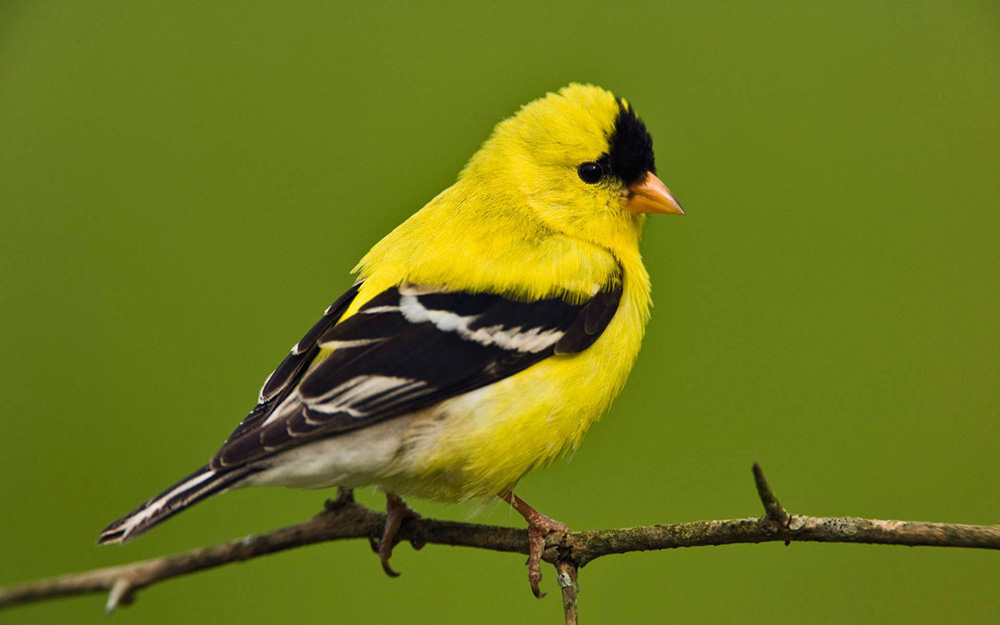
These birds are commonly seen in southern Arkansas during winter, while some remain in the northern part of the state throughout the year. Around 15% of summer checklists and 33% of winter checklists submitted by birdwatchers in Arkansas report sightings of American Goldfinches.
These birds are highly regarded due to the striking bright yellow and black coloration of the males during spring. The females and winter males, however, display a duller brown color.
Scientific Name: Spinus tristis
Size: 4.3-5.1 inches (11-13 cm)
Weight: 0.4-0.7 ounces (11-20 g)
Wingspan: 7.5-8.7 inches (19-22 cm)
American Goldfinches can be found throughout most of North America and are usually year-round residents. However, those that breed in Canada and the Midwest migrate to southern US states for the winter.
These birds can be found in weedy fields, overgrown areas, suburban regions, parks, and backyards, where they forage on sunflower, thistle, and aster plants. They are also commonly attracted to various bird feeders and have a preference for sunflower and nyjer seeds.
Interesting Fact: American Goldfinches have a purely vegetarian diet, which makes them unsuitable for raising young cowbirds. Consequently, cowbird chicks die within a few days when raised by American Goldfinches.
2. Yellow-rumped Warbler
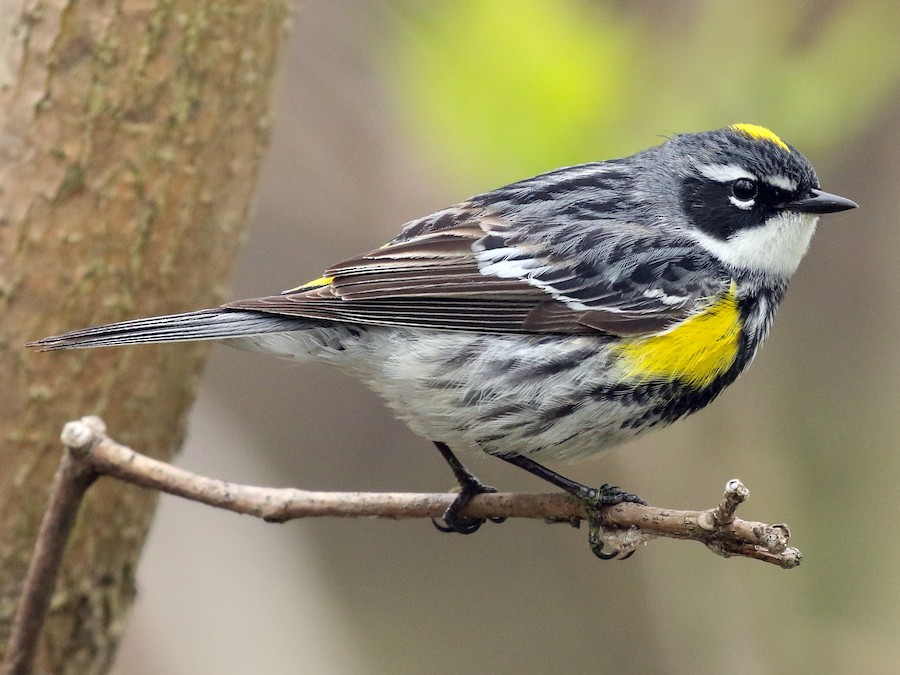
Yellow-rumped Warblers are winter visitors in Arkansas, arriving in September
and staying until May. The best months for observing them are from October to April, with sightings reported in 15% of winter checklists.
These warblers have gray plumage with flashes of yellow on their face, sides, and rump, as well as white markings on their wings.
Scientific Name: Setophaga coronata
Size: 4.7-5.5 inches (12-14 cm)
Weight: 0.4-0.5 ounces (12-13 g)
Wingspan: 7.5-9.1 inches (19-23 cm)
Yellow-rumped Warblers breed primarily in Canada, the Rockies, and the Appalachian mountains.
During migration, they can be observed in the Midwest before overwintering in southern and southwestern US states, along the Pacific Coast, Mexico, and Central America.
These warblers inhabit coniferous forests, particularly during the breeding season. In winter, they can be found in open areas with fruiting shrubs. Their diet consists mostly of insects during the summer and fruit during migration and winter, including bayberry and wax myrtle.
Interesting Fact: Yellow-rumped Warblers form large flocks numbering in the thousands during the winter and can display aggressiveness towards other species that get too close.
3. Eastern Meadowlark
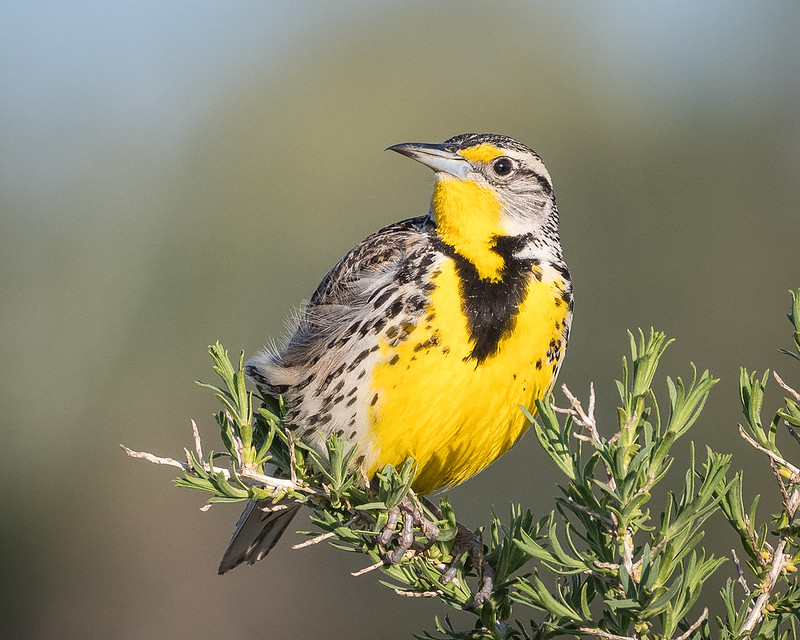
Eastern Meadowlarks, a near-threatened species, can be observed in Arkansas throughout the year, with sightings reported in 13% of summer checklists and 10% of winter checklists.
These medium-sized songbirds have bright yellow underparts, pale brown bodies with black markings on their backs, and a distinctive black band across their chests.
Scientific Name: Sturnella magna
Size: 7.5-10.2 inches (19-26 cm)
Weight: 3.2-5.3 ounces (90-150 g)
Wingspan: 13.8-15.8 inches (35-40 cm)
Eastern Meadowlarks are found across eastern US states year-round, with breeding populations also present in the Northeast and Canada. They migrate south during the winter months.
The arrival of spring in the Eastern US is often marked by the melodious songs and displays of Eastern Meadowlarks, although they are currently classified as near-threatened.
These birds can be found foraging on insects in grasslands, prairies, and fields. During winter, they gather in large flocks, searching for seeds.
Interesting Fact: Eastern Meadowlarks are capable of producing more than 100 different songs.
4. Pine Warbler
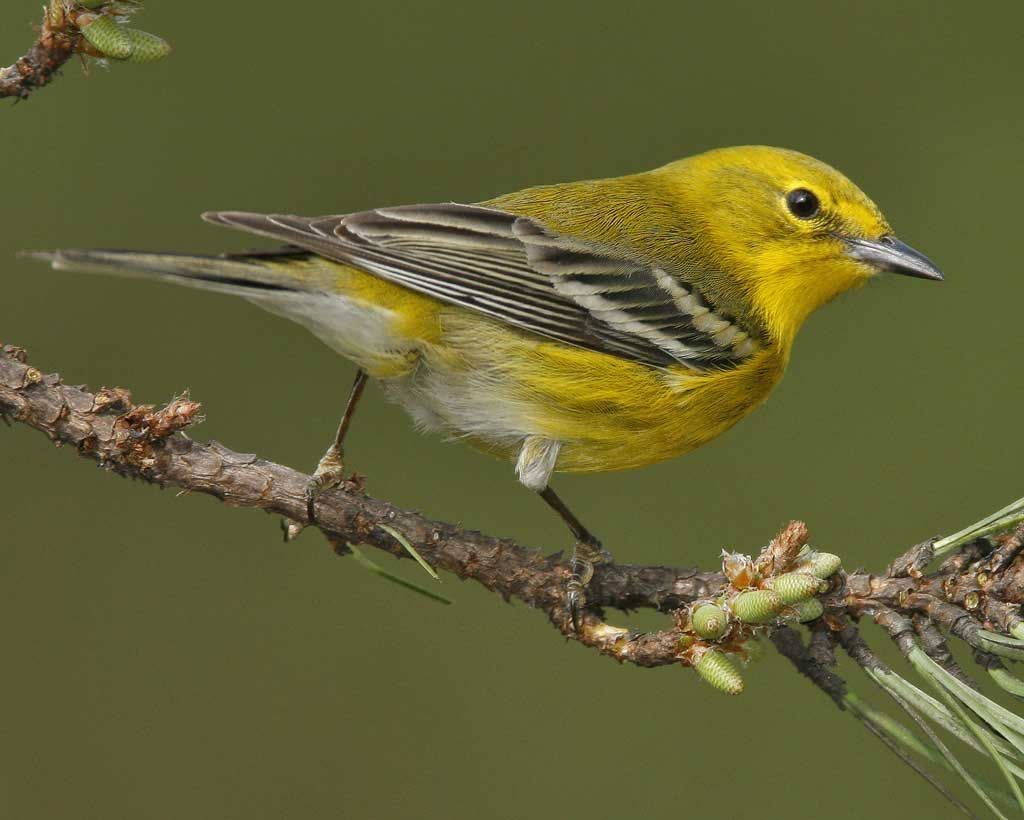
Pine Warblers can be spotted year-round in Arkansas and are reported in 11% of summer and winter checklists submitted by birdwatchers.
These small, plump yellow birds have olive-colored backs, white lower bellies, and gray wingbars. Female Pine Warblers may appear slightly browner and have more white on their bellies.
Scientific Name: Setophaga pinus
Size: 5.1-5.5 inches (13-14 cm)
Weight: 0.3-0.5 ounces (9-15 g)
Wingspan: 7.5-9.1 inches (19-23 cm)
Pine Warblers breed in northeastern US states before migrating to southeastern US states. Some individuals remain in the southeastern region year-round.
These warblers inhabit pine forests, often residing high up in the trees. Their diet primarily consists of caterpillars, beetles, spiders, and other insects and larvae. In colder weather, they also consume fruit and seeds.
Interesting Fact: Pine Warblers are one of the few warbler species that primarily feed on seeds, making them more likely to visit backyard feeders.
5. Summer Tanager Female

During the breeding season, Summer Tanagers are frequently sighted in Arkansas from April to October, accounting for 25% of checklists during this period.
Male Summer Tanagers are strikingly bright red birds with large, robust beaks, while females and juveniles exhibit mainly yellow plumage with hints of green on their backs.
Scientific Name: Piranga rubra
Size: 6.7 inches (17 cm)
Weight: 1.1 ounces (30 g)
Summer Tanagers breed in southern and eastern US states before migrating to Central and South America for winter.
These birds can be found in open woodlands, where they feed on bees and wasps mid-flight. To consume their prey, they kill them by striking them against a branch and rubbing off the stingers before consumption.
Interesting Fact: During winter, male Scarlet Tanagers continue to feed their young for an additional three weeks after leaving the nest, as the fledglings are not yet adept at flying.
6. White-eyed Vireo

White-eyed Vireos are observed during the breeding season in Arkansas, primarily from April to October, accounting for 20% of summer checklists.
These vireos have gray heads with yellow coloring around their foreheads and distinct white eyes. They display white throats and chests, yellow sides, greenish backs with darker wings, and two white wingbars.
Scientific Name: Vireo griseus
Size: 4.3-5.1 inches (11-13 cm)
Weight: 0.3-0.5 ounces (10-14 g)
Wingspan: 6.7 inches (17 cm)
White-eyed Vireos spend their summers across the southeastern United States, often concealed within thickets. Some individuals remain along the coast year-round, while they winter along the southeast coast of Mexico and the Caribbean.
These vireos can be found in overgrown pastures, brambles, and marshy areas, where they feed on insects, flies, and spiders. In winter, they supplement their diet with berries.
Interesting Fact: White-eyed Vireos produce a jumbled series of whistles that last approximately 3 to 4 seconds.
7. Cedar Waxwing

Cedar Waxwings are primarily observed in Arkansas during winter, from September to May, accounting for 8% of checklists during this period.
These elegant, sociable birds have pale brown heads, chests, and crests that fade to gray on their backs and wings. Their bellies display a pale yellow hue, and they possess bright yellow tips on their tails. Additionally, they feature narrow black masks over their eyes and bright red wingtips.
Scientific Name: Bombycilla cedrorum
Size: 5.5-6.7 inches (14-17 cm)
Weight: 1.1 ounces (32 g)
Wingspan: 8.7-11.8 inches (22-30 cm)
Cedar Waxwings breed in Canada before migrating to southern US states, Mexico, Central America, and northern South America for winter. They are year-round residents in northern US states.
These birds can be found in berry bushes, woodlands, grasslands, towns, and along streams. They primarily feed on fruit, but they also consume insects during the summer.
Interesting Fact: Cedar Waxwings engage in a gift-giving behavior during courtship, passing small items between potential mates.
8. Common Yellowthroat

During the breeding season, Common Yellowthroats are commonly spotted in Arkansas, with a few individuals staying year-round. They are primarily observed from April to October, accounting for 13% of summer checklists.
These small songbirds have brownish backs, bright yellow underparts, and long tails. Males display
black masks across their faces. The intensity of their yellow coloration can vary geographically, with some individuals appearing more olive underneath.
Scientific Name: Geothlypis trichas
Size: 4.3-5.1 inches (11-13 cm)
Weight: 0.3-0.3 ounces (9-10 g)
Wingspan: 5.9-7.5 inches (15-19 cm)
Common Yellowthroats breed across most of North America, excluding Alaska and northern Canada. Some individuals remain along the Gulf Coast and Pacific Southwest year-round, while others migrate south for winter.
These birds can often be found in marshy or wetland areas and brushy fields, thriving in dense, tangled vegetation.
Interesting Fact: The presence of a black mask on a Common Yellowthroat indicates to courting males that the bird is male. They exhibit aggression towards fake birds with masks but not towards those without masks.
9. Dickcissel

Dickcissels are predominantly observed in Arkansas during the breeding season, from mid-April to October, accounting for 13% of checklists.
Male Dickcissels are striking birds with black throat patches and yellow chests. Their grayish heads highlight the yellow eyebrow line. Females exhibit similar markings but with a slightly paler or duller coloration. Notably, females lack the black throat patch, and their yellow chests are fainter.
Scientific Name: Spiza americana
Size: 5.5-6.3 inches (14-16 cm)
Weight: 0.9-1.4 ounces (25.6-38.4 g)
Wingspan: 9.8-10.2 inches (24.8-26 cm)
Dickcissels breed in the Central and Great Plains of the US before migrating to Mexico, Central America, and northern South America.
These birds can be found in meadows, prairies, tall grasslands, lightly grazed pastures, and along roadsides. They feed on insects, such as grasshoppers, caterpillars, beetles, and crickets, during the summer. At other times, they may consume seeds, weeds, grasses, and cultivated grain.
Interesting Fact: During fall migration, Dickcissels form large flocks numbering from thousands to millions as they reach their winter grounds.
10. Orchard Oriole Female

Orchard Orioles can be observed in Arkansas during the breeding season from April to September, accounting for 10% of summer checklists.
Female Orchard Orioles have a predominantly greenish-yellow plumage, with a paler underside and darker back, including darker wings and white wingbars.
Scientific Name: Icterus spurius
Size: 5.9-7.1 inches (15-18 cm)
Weight: 0.6-1.0 ounce (16-28 g)
Wingspan: 9.8 inches (25 cm)
During summer, Orchard Orioles breed in the eastern half of the United States before migrating south to Mexico and Central America.
These orioles prefer open woodlands, and they are often found along riverbanks, open shrublands, farms, and even in backyard settings. They build hanging, pouch-like nests.
Orchard Orioles primarily feed on insects such as ants, caterpillars, beetles, and grasshoppers. They also drink nectar from flowers and consume fruit, including mulberries and chokeberries.
Interesting Fact: Orchard Orioles are the smallest blackbird species in North America.
Keep reading to explore the remaining yellow birds in Arkansas!
11. Baltimore Oriole

Baltimore Orioles can be spotted in Arkansas during the summer season, from April to September, appearing in 10% of summer checklists.
Male Baltimore Orioles are known for their vibrant orange plumage with black markings, while females exhibit a more muted combination of yellow and gray.
Scientific Name: Icterus galbula
Size: 7.9 inches (20 cm)
Weight: 1.0-1.5 ounces (28-42 g)
Wingspan: 9.8 inches (25 cm)
During summer, Baltimore Orioles breed across eastern North America. They migrate to Mexico, Central America, and northern South America for winter.
These orioles can be found in open woodlands, parks, and backyard settings. They primarily feed on nectar, fruits, and insects.
Interesting Fact: Baltimore Orioles are known for their intricately woven, hanging nests.
12. Yellow-throated Vireo

Yellow-throated Vireos are observed during the summer season in Arkansas, primarily from April to September, accounting for 9% of summer checklists.
These vireos have olive-green upperparts, yellow throats, and white spectacles around their eyes. They display a distinct contrast between their olive-colored backs and bright yellow underparts.
Scientific Name: Vireo flavifrons
Size: 5.5 inches (14 cm)
Weight: 0.5-0.6 ounces (15-17 g)
Wingspan: 9.1 inches (23 cm)
Yellow-throated Vireos breed across the eastern United States, and they migrate to Central and South America for winter.
These vireos inhabit deciduous forests, often staying high in the canopy. They primarily feed on insects, caterpillars, and spiders.
Interesting Fact: Yellow-throated Vireos are known for their melodious and repetitive songs.
13. Yellow-throated Warbler

Yellow-throated Warblers can be observed in Arkansas during the summer season, from April to September, appearing in 9% of summer checklists.
These warblers have yellow throats, black masks, and olive-green upperparts. Their underparts display a combination of white and yellow, with white wingbars.
Scientific Name: Setophaga dominica
Size: 5.5 inches (14 cm)
Weight: 0.4-0.5 ounces (11-14 g)
Wingspan: 8.3 inches (21 cm)
Yellow-throated Warblers breed across the southeastern United States. They migrate to Mexico, Central America, and the Caribbean for winter.
These warblers can be found in mature deciduous forests, particularly near water sources. They primarily feed on insects, spiders, and occasionally fruits.
Interesting Fact: Yellow-throated Warblers have a unique habit of foraging upside down on branches.
14. Prothonotary Warbler
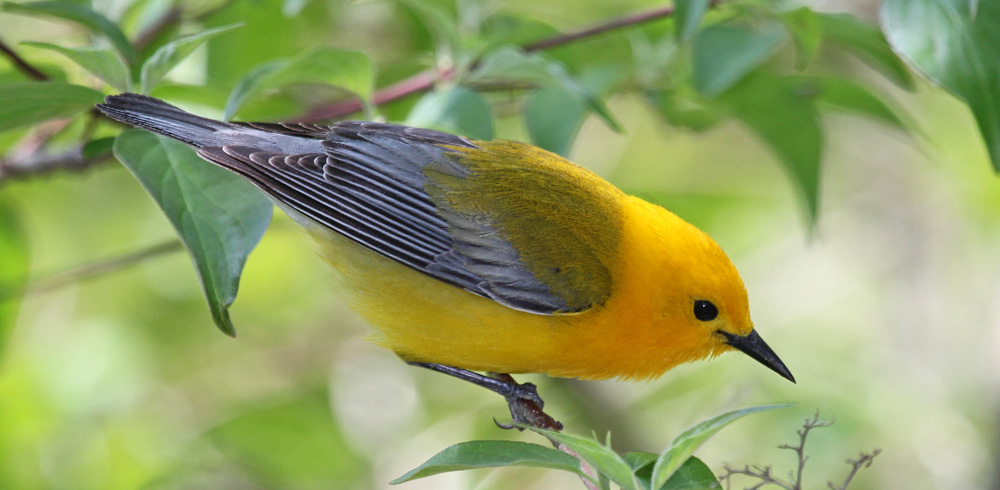
Prothonotary Warblers are predominantly observed in Arkansas during the summer season, from April to September, accounting for 9% of summer checklists.
These warblers have bright yellow plumage, contrasting with their gray wings and olive-colored backs. They possess a distinctive blue-gray coloration on their wings and tail.
Scientific Name: Protonotaria citrea
Size: 4.7 inches (12 cm)
Weight: 0.3-0.4 ounces (9-11 g)
Wingspan: 7.5 inches (19 cm)
Prothonotary Warblers breed across the eastern United States, with some individuals wintering in Central and South America.
These warblers can be found near swamps, marshes, and other wetland areas. They primarily feed on insects, spiders, and occasionally small crustaceans.
Interesting Fact: Prothonotary Warblers are known for their preference for nesting in natural or artificial cavities near water.
15. Hooded Warbler
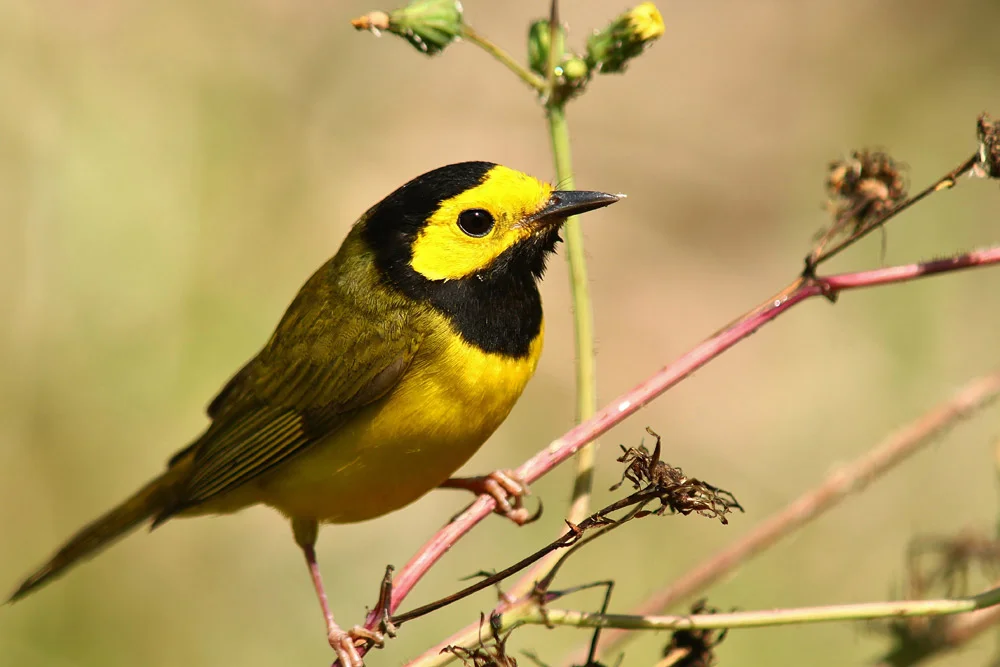
Hooded Warblers are commonly spotted in Arkansas during the summer season, from April to September, appearing in 9% of summer checklists.
Male Hooded Warblers have bright yellow bodies with contrasting black hoods and throats. Females exhibit a similar pattern but with more muted colors.
Scientific Name: Setophaga citrina
Size: 4.7 inches (12 cm)
Weight: 0.3-0.4 ounces (9-11 g)
Wingspan: 7.5 inches (19 cm)
Hooded Warblers breed across the eastern United States, migrating to Mexico and Central America for winter.
These warblers can be found in deciduous forests, particularly in understory areas with dense vegetation. They primarily feed on insects and spiders.
Interesting Fact: Hooded Warblers have a distinctive song that sounds like “twee-twee-twee-tee-o.”
16. Painted Bunting

Painted Buntings can be observed in Arkansas during the summer season, from April to September, appearing in 9% of summer checklists.
Male Painted Buntings are known for their vibrant plumage, featuring a combination of blue heads, red underparts, and green backs. Females display more subdued colors, with greenish upperparts and pale underparts.
Scientific Name: Passerina ciris
Size: 5.5 inches (14 cm)
Weight: 0.6-0.8 ounces (16-23 g)
Wingspan: 7.9 inches (20 cm)
Painted Buntings breed in the southeastern United States and migrate to Mexico and Central America for winter.
These buntings inhabit dense thickets, shrubs, and woodland edges. They primarily feed on seeds, fruits, and insects.
Interesting Fact: Male Painted Buntings undergo a molt each year, transitioning from dull green plumage to their brilliant breeding colors.
17. Scarlet Tanager
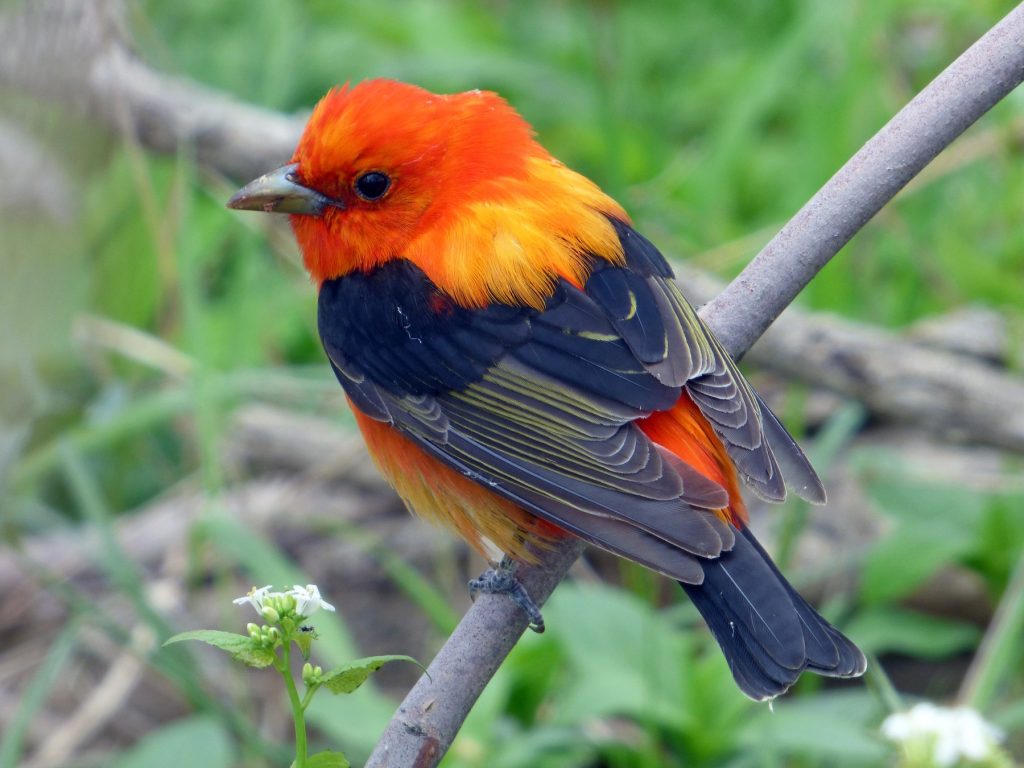
Scarlet Tanagers can be spotted in Arkansas during the summer season, from April to September, appearing in 9% of summer checklists.
Male Scarlet Tanagers are known for their striking red plumage, while females exhibit more subdued olive-yellow colors.
Scientific Name: Piranga olivacea
Size: 6.3 inches (16 cm)
Weight: 0.9-1.1 ounces (25-31 g)
Wingspan: 9.8 inches (25 cm)
Scarlet Tanagers breed across eastern North America and migrate to northern South America for winter.
These tanagers can be found in deciduous forests, particularly in the upper canopy. They primarily feed on insects, spiders, and fruits.
Interesting Fact: Scarlet Tanagers undergo a complete molt before migrating, transitioning from their vibrant red plumage to a greenish-yellow appearance.
18. Prairie Warbler
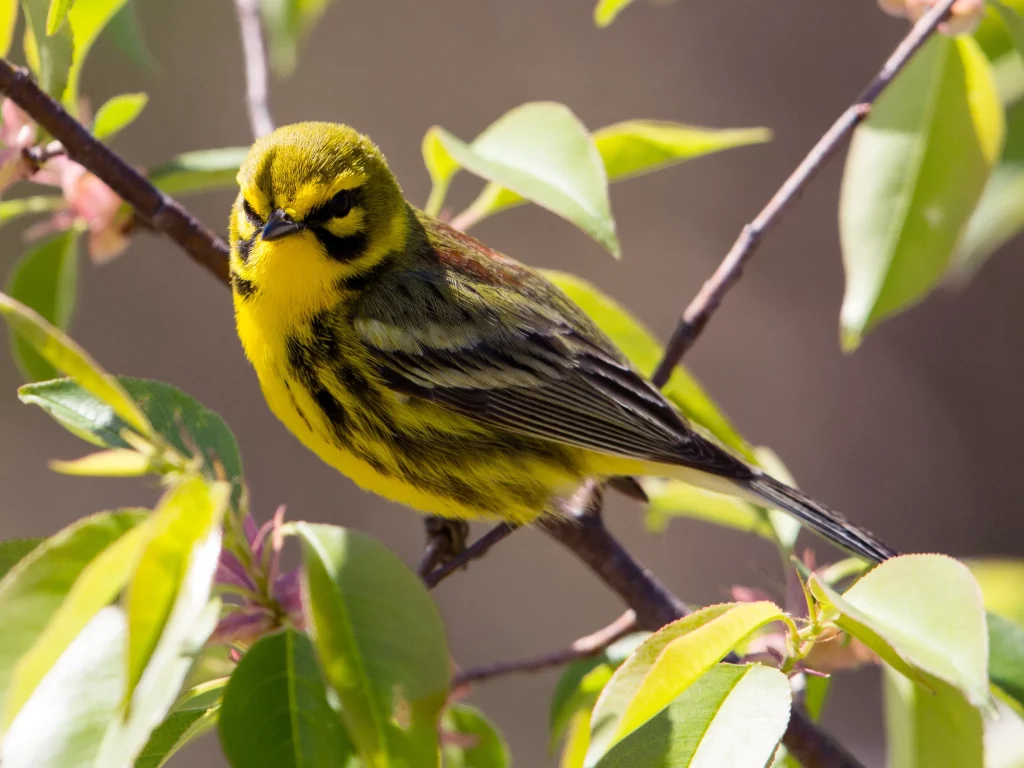
Prairie Warblers are predominantly observed in Arkansas during the summer season, from April to September, accounting for 9% of summer checklists.
These warblers have bright yellow bodies with black streaks on their sides and backs. They display a black mask across their faces.
Scientific Name: Setophaga discolor
Size: 4.7 inches (12 cm)
Weight: 0.3-0.4 ounces (9-11 g)
Wingspan: 7.5 inches (19 cm)
Prairie Warblers breed across the eastern United States and migrate to the Caribbean and Central America for winter.
These warblers can be found in open habitats, such as grasslands, shrubby areas, and
pine barrens. They primarily feed on insects and spiders.
Interesting Fact: Prairie Warblers have a distinctive buzzy song that sounds like “zee-zee-zee-zoo-zee.”
19. Blue-winged Warbler

Blue-winged Warblers can be observed in Arkansas during the summer season, from April to September, appearing in 9% of summer checklists.
These warblers have bright yellow bodies with bluish-gray wings. They display a yellow crown and eyering.
Scientific Name: Vermivora cyanoptera
Size: 4.7 inches (12 cm)
Weight: 0.3-0.4 ounces (9-11 g)
Wingspan: 7.5 inches (19 cm)
Blue-winged Warblers breed across the eastern United States and migrate to Mexico and Central America for winter.
These warblers can be found in early successional habitats, such as regenerating forests and shrubby areas. They primarily feed on insects and spiders.
Interesting Fact: Blue-winged Warblers occasionally hybridize with Golden-winged Warblers, resulting in offspring with mixed characteristics.
20. Western Kingbird
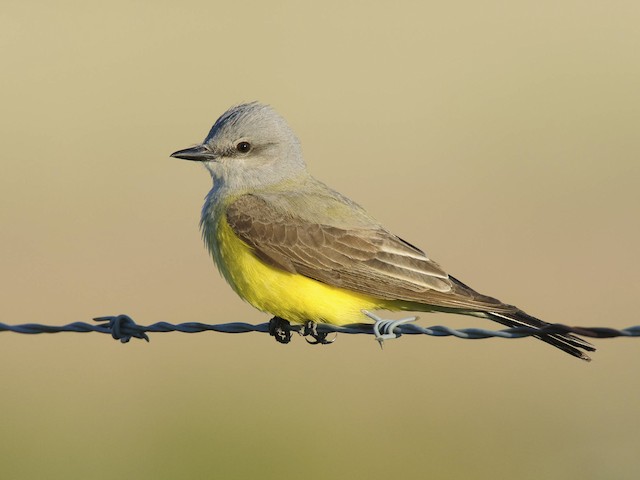
Western Kingbirds are primarily spotted in Arkansas during the summer season, from April to September, appearing in 9% of summer checklists.
These kingbirds have gray upperparts and yellow underparts. They display a gray head with a concealed yellow crown patch.
Scientific Name: Tyrannus verticalis
Size: 8.3 inches (21 cm)
Weight: 1.0-1.1 ounces (28-32 g)
Wingspan: 15.0 inches (38 cm)
Western Kingbirds breed across western North America and migrate to Central America for winter.
These kingbirds can be found in open habitats, including grasslands, shrublands, and agricultural areas. They primarily feed on insects, especially flying insects caught in mid-air.
Interesting Fact: Western Kingbirds are known for their aggressive behavior, often defending their territory against larger birds.
21. American Goldfinch
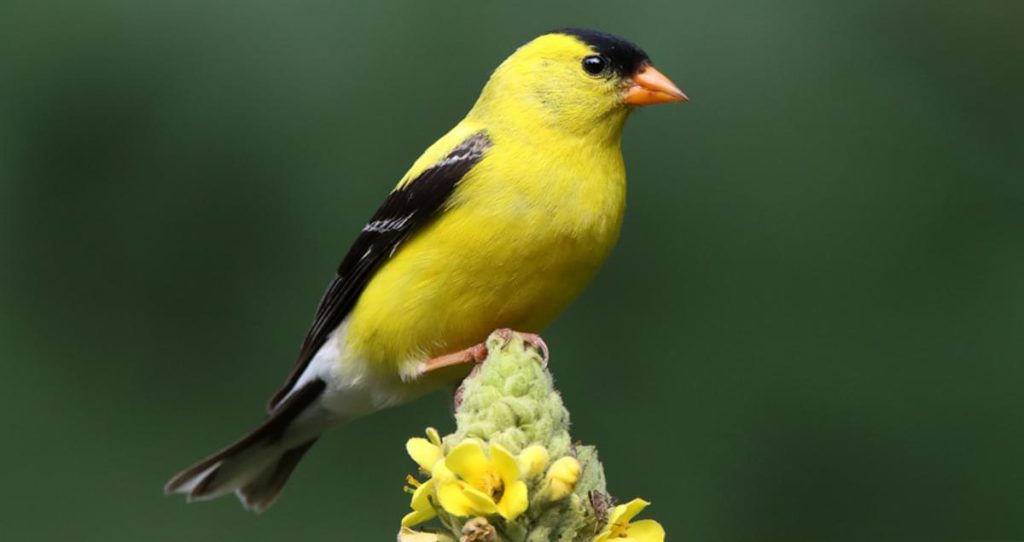
American Goldfinches can be observed in Arkansas throughout the year. They are predominantly seen during winter in southern Arkansas, while some individuals remain year-round in the north of the state. They appear in 15% of summer checklists and 33% of winter checklists submitted by bird watchers.
American Goldfinches are popular birds known for the bright yellow and black coloring of males in spring. Females and males in winter exhibit duller brown plumage.
Scientific Name: Spinus tristis
Size: 4.3-5.1 inches (11-13 cm)
Weight: 0.4-0.7 ounces (11-20 g)
Wingspan: 7.5-8.7 inches (19-22 cm)
American Goldfinches are widespread across most of North America. While some individuals are resident year-round, those that breed in Canada and the Midwest migrate to southern US states for winter.
These finches can be found in weedy fields, overgrown areas, suburbs, parks, and backyards. They primarily feed on seeds from sunflowers, thistles, and aster plants.
Interesting Fact: American Goldfinches build their nests using rootlets and plant material woven together and held firm with spiders’ webs.
22. Yellow-rumped Warbler

Yellow-rumped Warblers are observed in Arkansas during the winter season, from October to April, appearing in 15% of winter checklists.
These warblers have gray plumage with flashes of yellow on the face, sides, and rump, as well as white in the wings.
Scientific Name: Setophaga coronata
Size: 4.7-5.5 inches (12-14 cm)
Weight: 0.4-0.5 ounces (12-13 g)
Wingspan: 7.5-9.1 inches (19-23 cm)
Yellow-rumped Warblers breed predominantly in Canada and parts of the Rockies and the Appalachian Mountains. They can be seen in the Midwest during migration before overwintering in southern and southwestern US states, the Pacific Coast, Mexico, and Central America.
These warblers can be found in coniferous forests during the breeding season and open areas with fruiting shrubs during winter. They primarily feed on insects during the summer and switch to a diet of fruits, including bayberry and wax myrtle, during winter.
Interesting Fact: Yellow-rumped Warblers are known for their ability to digest waxy fruits, such as bayberries, which are not typically consumed by other warbler species.
23. Cedar Waxwing
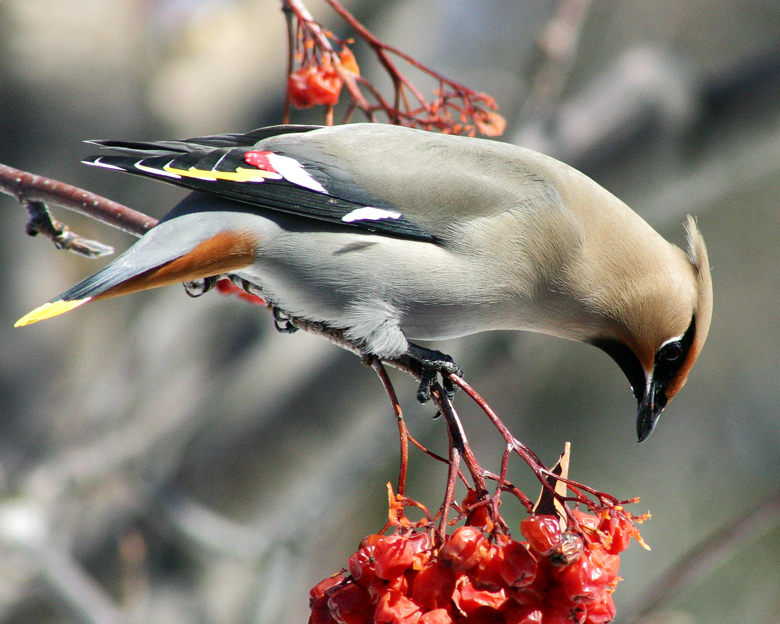
Cedar Waxwings are predominantly observed in Arkansas during the winter season, from September to May, accounting for 8% of checklists during this time.
These elegant social birds have pale brown heads, chests, and crests, which fade to gray on their backs and wings. They exhibit a pale yellow belly and bright yellow tips on their tails. A narrow black mask extends over their eyes, and they have bright red wingtips.
Scientific Name: Bombycilla cedrorum
Size: 5.5-6.7 inches (14-17 cm)
Weight: 1.1 ounces (32 g)
Wingspan: 8.7-11.8 inches (22-30 cm)
Cedar Waxwings breed in Canada and migrate to the southern US, Mexico, and Central America for winter. They are resident year-round in northern US states.
These waxwings can be found in berry bushes, woodlands, grasslands, towns, and along streams. They primarily feed on fruit, such as berries, but also consume insects during the summer.
Interesting Fact: Cedar Waxwings are known for their unique habit of passing berries or fruits between individuals as a form of social interaction.
24. Orange-crowned Warbler

Orange-crowned Warblers can be observed in Arkansas during the winter season, from October to April, appearing in 8% of winter checklists.
These warblers have plain olive-green plumage, with males occasionally exhibiting a hidden orange crown patch that is often difficult to see.
Scientific Name: Leiothlypis celata
Size: 4.7 inches (12 cm)
Weight: 0.3-0.4 ounces (9-11 g)
Wingspan: 7.5 inches (19 cm)
Orange-crowned Warblers breed across western North America and parts of Canada. They migrate to the southern US, Mexico, and Central America for winter.
These warblers can be found in a variety of habitats, including woodlands, shrublands, and thickets. They primarily feed on insects, spiders, and berries.
Interesting Fact: The orange crown patch in Orange-crowned Warblers is often concealed and is only occasionally displayed during territorial or courtship displays.
25. Western Meadowlark

Western Meadowlarks are predominantly observed in Arkansas during the winter season, from October to April, accounting for 8% of winter checklists.
These meadowlarks have bright yellow underparts, with black V-shaped markings on their chests. They exhibit brown upperparts and striped heads.
Scientific Name: Sturnella neglecta
Size: 9.8-10.5 inches (25-27 cm)
Weight: 3.9-5.0 ounces (110-140 g)
Wingspan: 16.1-17.7 inches (41-45 cm)
Western Meadowlarks breed across
western North America and migrate to the southern US and Mexico for winter.
These meadowlarks can be found in grasslands, prairies, and agricultural fields. They primarily feed on insects, spiders, seeds, and fruits.
Interesting Fact: Western Meadowlarks are known for their melodious and flute-like songs, which are often associated with open grassland habitats.
26. Evening Grosbeak
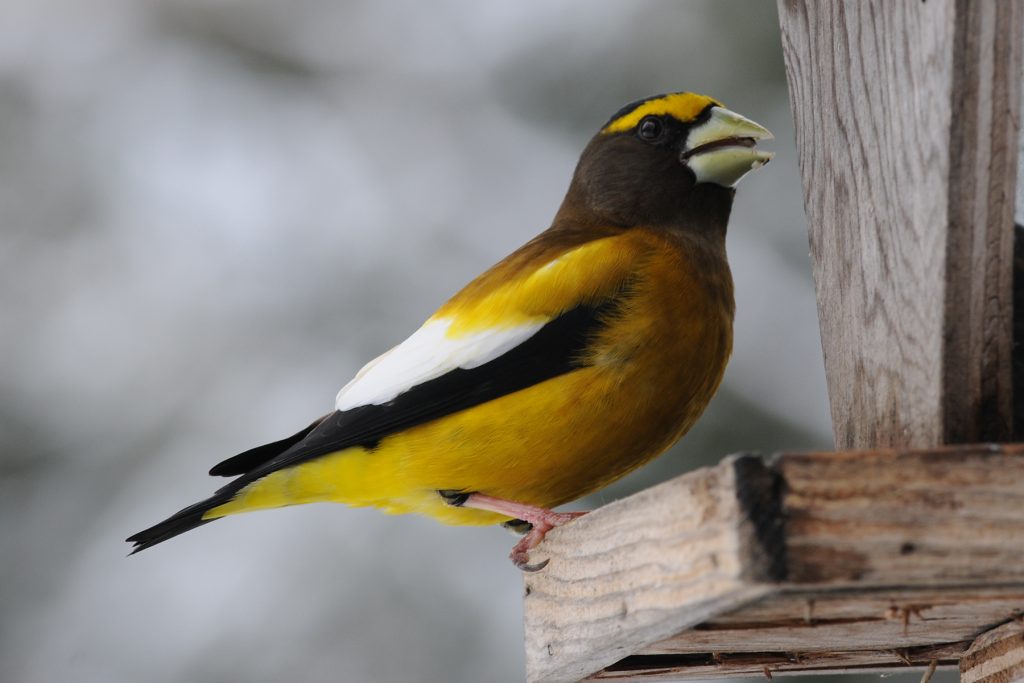
Evening Grosbeaks can be observed in Arkansas during the winter season, from October to April, appearing in 8% of winter checklists.
These grosbeaks have a distinctive appearance, with large, thick bills and a combination of yellow, black, and white plumage. Males exhibit brighter colors than females.
Scientific Name: Coccothraustes vespertinus
Size: 7.5-8.7 inches (19-22 cm)
Weight: 2.3-3.7 ounces (65-105 g)
Wingspan: 13.8-15.0 inches (35-38 cm)
Evening Grosbeaks breed in coniferous forests across western North America. They undergo irregular irruptions, often migrating to different regions in search of food during the winter.
These grosbeaks can be found in forests, woodlands, and sometimes in backyards. They primarily feed on seeds, fruits, and buds.
Interesting Fact: Evening Grosbeaks have a unique call that sounds like “cheek” or “twick.” Their name “Evening” Grosbeak is misleading, as they can be active throughout the day.
27. Nashville Warbler
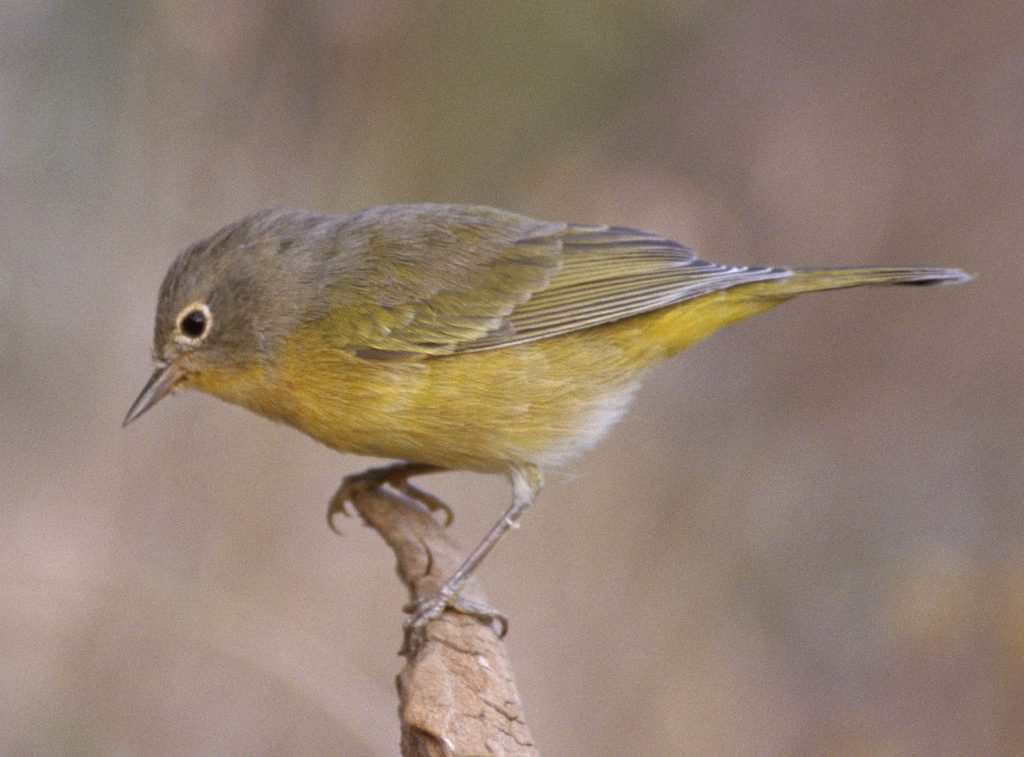
Nashville Warblers are primarily observed in Arkansas during migration, appearing in 7% of checklists during this time.
These warblers have olive-green upperparts, bright yellow underparts, and a white eye-ring. They display a gray head with a distinctive bright yellow patch.
Scientific Name: Leiothlypis ruficapilla
Size: 4.7 inches (12 cm)
Weight: 0.3-0.4 ounces (9-11 g)
Wingspan: 7.5 inches (19 cm)
Nashville Warblers breed in the boreal forests of Canada and parts of the northern US. They migrate through Arkansas and other parts of the United States during spring and fall migration.
These warblers can be found in a variety of habitats, including woodlands, thickets, and shrubby areas. They primarily feed on insects and spiders.
Interesting Fact: Nashville Warblers are named after the city of Nashville, Tennessee, where one of the first specimens of this species was collected.
28. American Redstart

American Redstarts can be observed in Arkansas during migration, appearing in 7% of checklists during this time.
These warblers have black upperparts with bright orange patches on their wings, tail, and sides. They display bright yellow underparts.
Scientific Name: Setophaga ruticilla
Size: 4.3-5.1 inches (11-13 cm)
Weight: 0.3-0.4 ounces (9-11 g)
Wingspan: 6.7 inches (17 cm)
American Redstarts breed across parts of eastern North America and migrate to Central and South America for winter.
These warblers can be found in various habitats, including forests, woodlands, and riparian areas. They primarily feed on insects, catching them in mid-air.
Interesting Fact: Male American Redstarts are known for their unique flashing behavior, in which they fan out their bright orange tail patches to startle insects, making them easier to catch.
29. Black-throated Green Warbler
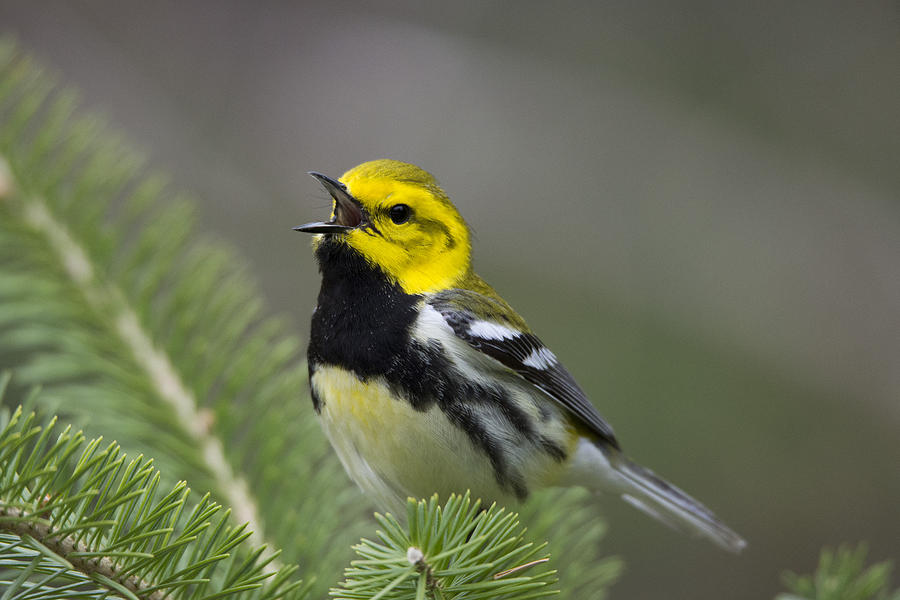
Black-throated Green Warblers can be observed in Arkansas during migration, appearing in 7% of checklists during this time.
These warblers have olive-green upperparts, bright yellow underparts, and a black throat and face. They display white wingbars.
Scientific Name: Setophaga virens
Size: 4.7 inches (12 cm)
Weight: 0.3-0.4 ounces (9-11 g)
Wingspan: 7.5 inches (19 cm)
Black-throated Green Warblers breed across the northeastern United States and parts of Canada. They migrate through Arkansas and other parts of the eastern US during spring and fall migration.
These warblers can be found in various forest habitats, including coniferous and mixed forests. They primarily feed on insects, spiders, and occasionally berries.
Interesting Fact: Black-throated Green Warblers have a distinctive song that sounds like “zee-zee-zoo-zoo-zee.”
30. Blackburnian Warbler
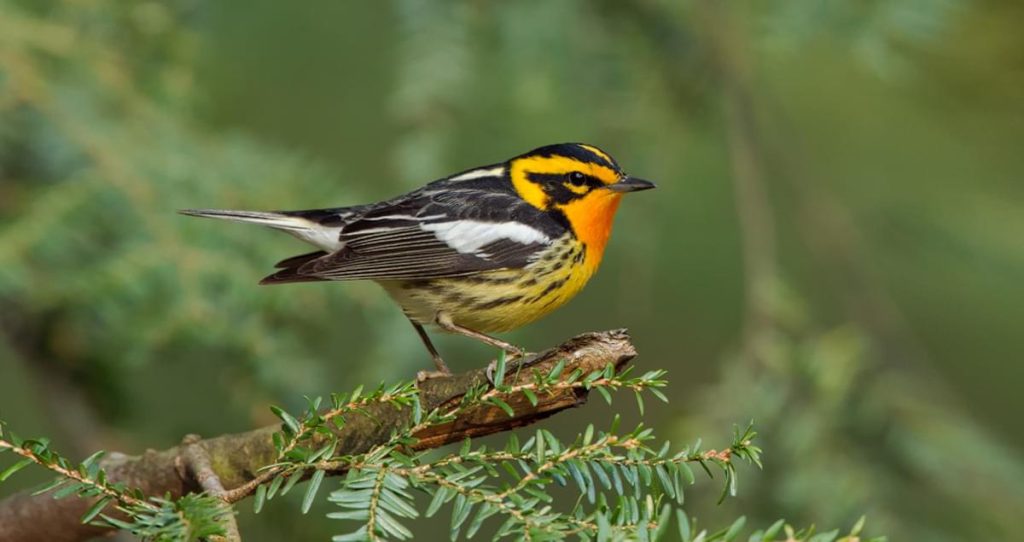
Blackburnian Warblers can be observed in Arkansas during migration, appearing in 7% of checklists during this time.
These warblers have black upperparts, bright orange throats and chests, and white bellies. They display yellow wingbars.
Scientific Name: Setophaga fusca
Size: 4.7 inches (12 cm)
Weight: 0.3-0.4 ounces (9-11 g)
Wingspan: 7.5 inches (19 cm)
Blackburnian Warblers breed in the boreal forests of Canada and parts of the northeastern US. They migrate through Arkansas and other parts of the eastern US during spring and fall migration.
These warblers can be found in coniferous forests and high-elevation forests. They primarily feed on insects, spiders, and occasionally berries.
Interesting Fact: Male Blackburnian Warblers are known for their stunning orange plumage, often considered one of the most beautiful among North American warblers.
31. Swainson’s Warbler
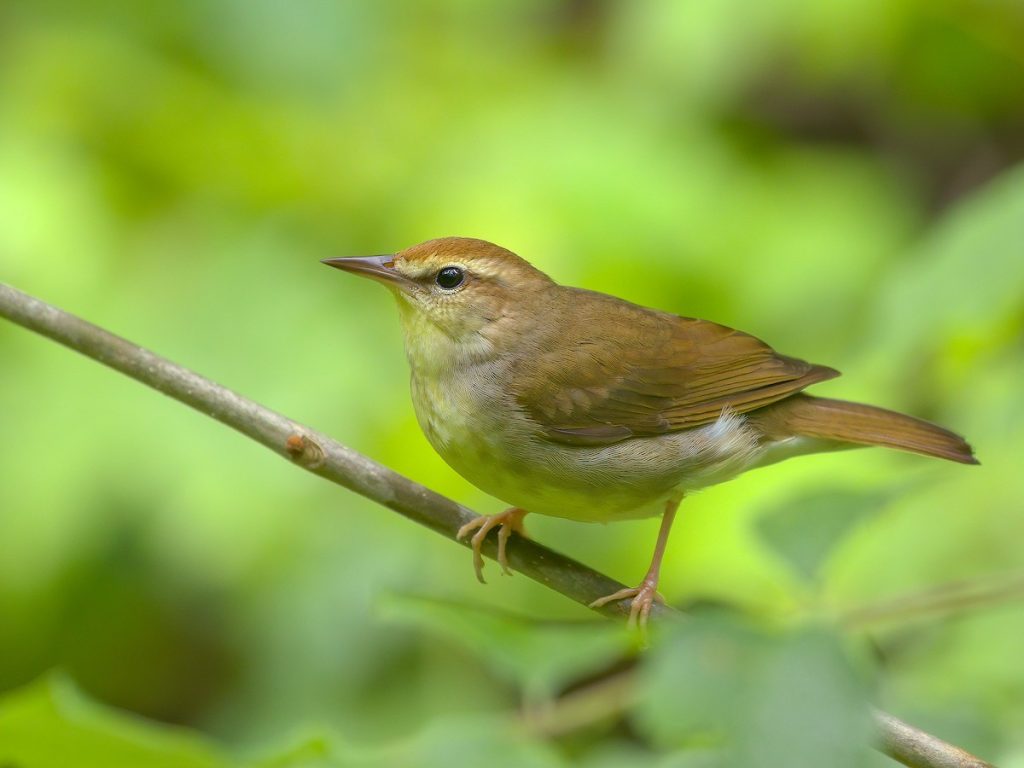
Swainson’s Warblers are predominantly observed in Arkansas during migration, appearing in 6% of checklists during this time.
These warblers have plain brown plumage with a slightly olive tint. They display a pale yellow eyebrow and throat.
Scientific Name: Limnothlypis swainsonii
Size: 5.5 inches (14 cm)
Weight: 0.4-0.5 ounces (11-14 g)
Wingspan: 8.3 inches (21 cm)
Swainson’s Warblers breed primarily in the southeastern United States and migrate to Central America for winter.
These warblers can be found in dense understory habitats, such as swamps, bottomland forests, and cane thickets. They primarily feed on insects, spiders, and occasionally small crustaceans.
Interesting Fact: Swainson’s Warblers are known for their secretive nature, often staying hidden in dense vegetation and rarely seen out in the open.
32. Grasshopper Sparrow

Grasshopper Sparrows can be observed in Arkansas during migration, appearing in 6% of checklists during this time.
These sparrows have streaked brown plumage with a flat head and short tail. They display a white eye-ring and a yellowish patch on the face.
Scientific Name: Ammodramus savannarum
Size: 4.7 inches (12 cm)
Weight: 0.4-0.6 ounces (11-17 g)
Wingspan: 7.5 inches (19 cm)
Grasshopper Sparrows breed across central and eastern North America and migrate to the southern US, Mexico, and Central America for winter.
These sparrows can be found in open grasslands, prairies, and agricultural fields. They primarily feed on insects, seeds, and grasshoppers.
Interesting Fact: Grasshopper Sparrows are known for their distinct insect-like song, which sounds like a series of high-pitched buzzing notes.
33. Eastern Towhee
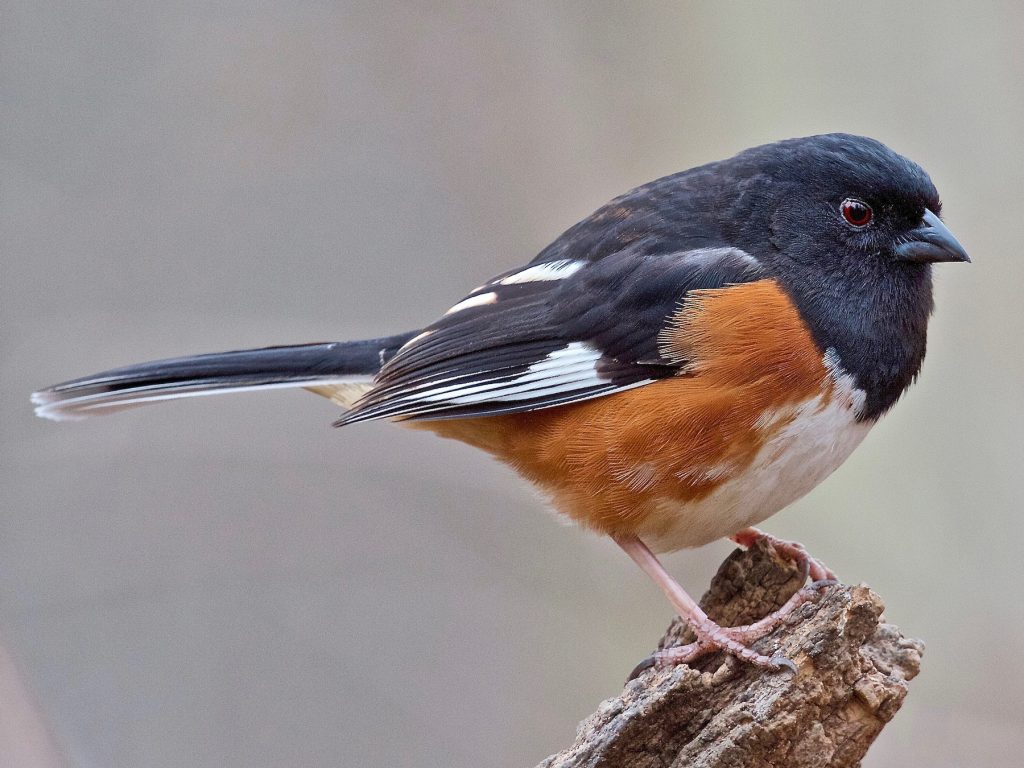
Eastern Towhees are predominantly observed in Arkansas during migration, appearing in 6% of checklists during this time.
These large sparrows have black upperparts, reddish-brown sides, and white underparts. Males display a distinctive black head and upper breast, while females have a more brownish appearance.
Scientific Name: Pipilo erythrophthalmus
Size: 6.8-8.2 inches (17-21 cm)
Weight: 1.1-1.8 ounces (31-52 g)
Wingspan: 8.7-11.0 inches (22-28 cm)
Eastern Towhees breed across eastern North America and parts of the Midwest. They migrate through Arkansas and other parts of the eastern US during spring and fall migration.
These towhees can be found in dense shrubby habitats, woodland edges, and overgrown fields. They primarily feed on insects, seeds, and berries.
Interesting Fact: Eastern Towhees have a distinctive call that sounds like “drink your tea!” Their name “towhee” is derived from this call.